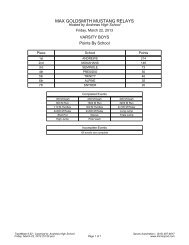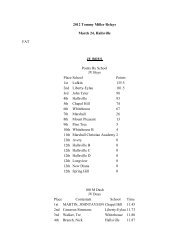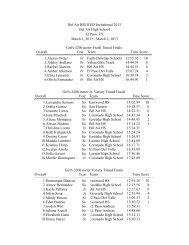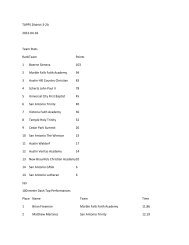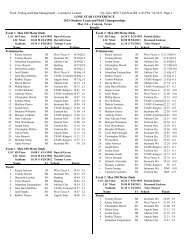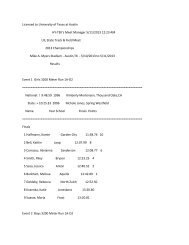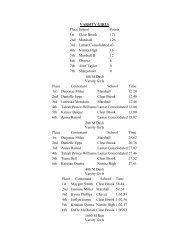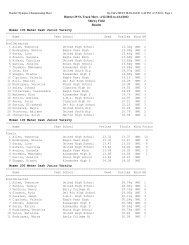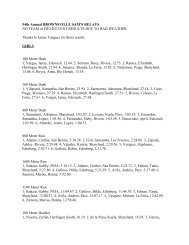1. PAGES 1-35 - Texas Track & Field Coaches Association
1. PAGES 1-35 - Texas Track & Field Coaches Association
1. PAGES 1-35 - Texas Track & Field Coaches Association
You also want an ePaper? Increase the reach of your titles
YUMPU automatically turns print PDFs into web optimized ePapers that Google loves.
COACHING YOUTHS<br />
Figure 5. The three body types<br />
NO BODY (NOBODY) IS PERFECT<br />
Effective coaches embrace the uniqueness of each athlete.<br />
There is variability among athletes and within each<br />
student. The coach’s job is to leverage the potential of<br />
each athlete by understanding how children are different,<br />
how they develop, and how they learn. Physique is<br />
described by 3 body shapes (Figure 5). The apple-or pearshaped<br />
body (endomorph), the muscular body (mesomorph)<br />
and the linear body (ectomorph). Most people<br />
are a combination of two. Early maturing females tend to<br />
be endomorphs, and later maturing children tend to be<br />
ectomorphs. Individuals usually have little control over<br />
their physique. Physical activity and healthy eating allow<br />
people to make the most of their physique. As a coach<br />
you can help children understand that a) there is no ideal<br />
body shape, b) we are all more alike than different and c)<br />
all of us can have healthy bodies. The emphasis on body<br />
type creates two additional problems:<br />
It shifts the focus away from athletic improvement, a<br />
positive behavior, and toward body weight.<br />
In some people, it may encourage unhealthy eating and<br />
a desire to be “too thin.”<br />
What is also important for children and adolescents to<br />
understand is that larger bones and a healthy amount of<br />
muscle are good. Their participation in track and field<br />
can help by increasing muscle and bone growth, and<br />
reducing fat. Although a moderate level of skill is important<br />
in order to enjoy most sports, you do not have to be<br />
an expert to enjoy track and field. The task for youth<br />
coaches is to provide all children with a variety of skills so<br />
they can choose events in which they can enjoy success.<br />
Success does not mean winning; success means participating<br />
regularly and performing effectively relative to skill<br />
level and expectations.<br />
REFERENCES<br />
Bar-Or, O. (1983). Pediatric sports medicine for the<br />
practitioner. New York, NY: Springer-Verlag.<br />
Espenschade, A. and Eckert, H. (1974). Motor<br />
Development. Science and medicine of exercise and sport<br />
(2nd ed.). New York, NY: Harper & Howl.<br />
Faigenbaum, A.D., Westcott, W.L., Loud, R.L., and Long,<br />
C. (1999). The effects of different resistance training protocols<br />
on muscular strength and endurance development in<br />
children. Pediatrics, 104, 5.<br />
Malina, R.M. (1984). Physical growth and maturation. In<br />
Motor Development during childhood and adolescence.<br />
Minneapolis, MN: Burgess.<br />
Scanlan, T.K. (1995). Social evaluation and the competitive<br />
process: A developmental perspective. In Children and<br />
youth in sports: A biopsychosocial perspective. Dubuque,<br />
IA: Brown & Benchmark.<br />
Thomas, K.T. and Thomas, J.R. (1999). What squirrels in<br />
trees predict about expert athletes. International Journal of<br />
Sport Psychology, 30, 221-234.<br />
Thomas, J.R. and French, K.E. (1985). Gender differences<br />
across age in motor performance; A meta-analysis.<br />
Psychological Bulletin, 98, 260-282.<br />
Matthew Buns, PhD, Concordia University Chicago<br />
can be reached at matthew.buns@cuchicago.edu or<br />
641-512-1736.<br />
22 techniques AUGUST 2011



